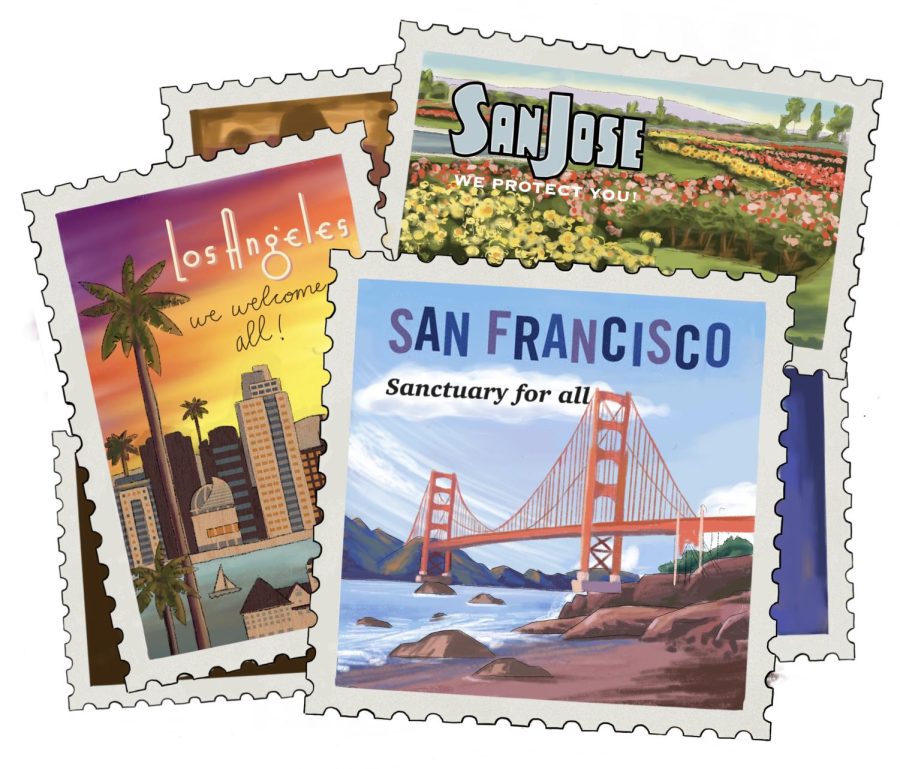Sanctuary cities keep undocumented immigrants protected
Graphic illustration by Catherine Zhou
Sanctuary cities provide a safe haven to all undocumented immigrants and provide them with a comfortable living space and education without being shamed in public or deported by ICE for being undocumented.
March 8, 2022
In July 2015, 32-year-old Kate Steinle was murdered in San Francisco, allegedly by Garcia Zarate, an undocumented immigrant. Controversies about San Francisco’s sanctuary policies, which protect undocumented immigrants, spiraled because many felt they enabled Zarate’s residence in the country. Although Zarate was later acquitted, Steinle’s death sparked a national debate on the necessity of sanctuary cities.
Sanctuary cities like San Francisco limit the volunteering of resources to aid immigration enforcement and forbid city workers involved with the U.S. Immigration and Customs Enforcement to use city funding and expenses to enforce immigration policy unless the federal government requires them to do so. This opened the way for Zarate to enter and stay in San Francisco without interference from ICE.
The term “sanctuary city” originated from the Sanctuary Movement of the 1980s, which began due to wars in Central America. Undocumented immigrants from countries like El Salvador and Guatamela escaped to the U.S. hoping for better lives. However, many were swiftly deported by ICE, and this treatment catalyzed the creation of sanctuary groups dedicated to providing a place of freedom and opportunity for uncodumented immigrants.
“Sanctuary cities protect the most vulnerable in our communities because they don’t have a home to go back to,” said Hyon Chu Yi-Baker, faculty director of college life and judicial conduct at De Anza College. “It’s to protect the basics of human rights and life to ensure that, as worldly citizens, we provide a safe place for someone who’s trying to escape a life of violence and poverty.”
In the 1980s, increasing numbers of religious establishments and private organizations declared themselves as sanctuary groups, but many immigrants were still afraid of deportation. The San Francisco police continuously aided immigration agents with their raids. Immigrants were randomly searched and forced to prove that they were legal U.S. residents, facing deportation otherwise.
Local governments took inspiration from sanctuary groups and began to establish immigrant-safe policies Berkeley, Calif. became the first sanctuary city in 1971. Since then, 560 cities nationwide — including major Bay Area cities of San Jose, San Francisco and Oakland — have obtained the same designation.
In 1989, due immigrant community outrage, San Francisco passed the City and County of Refuge Ordinance, which prohibits the city from using funds to aid ICE unless required by federal or state law.
The city’s refusal to cooperate with authorities inspired controversy, to the point where the city was at risk of losing federal funding. In 1992, San Francisco amended its policy to exclude felons from the protections of the ordinance.
However, the debate on San Francisco’s sanctuary power increased in 2008 after Edwin Ramos, an undocumented immigrant, was convicted of murdering three people. He was arrested for several crimes as a youth but was protected from deportation due to the sanctuary law.
In a response inspiring equal controversy, the San Francisco Mayor at the time, Gavin Newsom, ordered that juveniles suspected of crimes would be reported to immigration agencies.
In 2013, the next San Francisco Mayor, Ed Lee, signed the Due Process for All Law, which further limited cooperation with ICE by stating city officers can hold advance notice of a person’s release from jail and prohibiting ICE detainer requests — orders to hold jailed people longer so ICE agents can have more time to decide on deportation.
These policies were last amended in 2016 when former President Donald Trump attacked San Francisco’s sanctuary policy, claiming that these rules made the city more susceptible to crime. The current sanctuary policy allows officers to contact immigration agents in limited circumstances and only if a judge determines that there is probable cause to hold the defendant on the charges.
“While sanctuary cities are necessary to protect immigrants, the federal government should be the one to address these issues as they have a lot more resources that can help immigrants,” Lynbrook Intersections Co-President Riya Abriam said. “These cities reflect how poor the U.S. immigration policies are right now.”
In 2017, the state of California became a sanctuary state when Governor Jerry Brown signed a bill that extends sanctuary city protections to undocumented immigrants living in California and prevent immigration agencies from inquiring about a person’s immigration status.
“If you are an undocumented person who has witnessed a crime and you don’t trust the police, you’re probably not going to call and report it because you’re afraid of getting arrested yourself,” De Anza College political science professor Jim Ngyuen said. “In a sanctuary community, there is some trust between the police and undocumented immigrants to the point where immigrants feel safe to call the police.”
At the same time, these cities are greatly underfunded and often lose federal funding. With limited money, sanctuary cities lack the proper resources to help a large group of people.
Recently, some schools have disentangled themselves from federal immigration laws and been renamed “sanctuary schools”.
“Sanctuary schools provide a safe space for students to feel like they are somewhat safe, because technically a lot of campuses are public so ICE has the right to enter,” said Angelica Esquivel Moreno, immigrant and Association of Classified Employees Executive Board member at De Anza College. “Sanctuary schools are a step in the right direction, but it definitely is not necessarily protecting communities.”
On June 24, 2020, the San Francisco Unified School District officially established their schools as sanctuary schools. They have administered several programs such as the Rise-SF Program and the Rapid Response Network, important programs providing safety and inclusivity to immigrant students.
The Rapid Response Network’s unique 24-hour support immigrants if ICE is involved or an immigrant students arrested for their immigration status.
Sanctuary cities provide a safe haven to all undocumented immigrants and provide them with a comfortable living space and education without being shamed in public or deported by ICE for being undocumented.
“Not everything in the world is fair,” Yi-Baker said. “But, by allowing and supporting these sanctuary cities, it’s our way of showing that we still believe in humanity and that there is hope and optimism in helping one another.”




































































